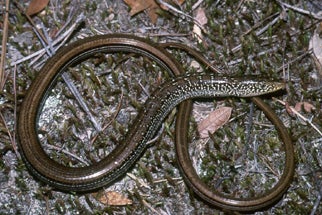SCIENTIFIC NAME:
Ophisaurus mimicus (Palmer)
OTHER NAMES:
Legless Lizard, Glass Snake.
STATUS:
Uncommon to rare, secretive, and possibly threatened throughout. Three documented occurences from southern portion of Alabama's Dougherty Plain and Southern Pine Plains and Hills. HIGHEST CONSERVATION CONCERN.
DESCRIPTION:
A long, slender, limbless lizard superficially resembling a snake, relatively recently described (Palmer 1987). Glass lizards distinguished from snakes by presence of a lateral fold along each side of body, moveable eyelids, a pair of ear openings, and scales reinforced with bony plates (osteoderms), making their bodies feel relatively rigid. Mimic glass lizards are easily the smallest of three native Alabama species of Ophisaurus,with a maximum snout-vent length (SVL) of 181 millimeters (7.1 inches) (Palmer 1987).
The slender glass lizard and eastern glass lizard may exceed 300 millimeters (11.7 inches) SVL. Tails are extremely long, typically about two-thirds of full length unless shortened by injury; quite fragile and readily break owing to fracture planes in tail vertebrae (Palmer 1987). Only counting scale rows along the lateral fold can positively identify mimic glass lizards (<96 vs. >98 in other two) (Palmer 1987, Moler 1992b). Dorsal color tan to brown and may or may not have light and dark speckling. Usually a mid-dorsal dark stripe on body and most of tail, but may be faint. Narrow, lateral stripes present on most of tail and above fold on posterior portion of body. Lateral stripes below fold faint. Vertical bars may be present on side of neck. Belly is pale (Palmer 1987).
DISTRIBUTION:
Lower Coastal Plain from southeastern North Carolina to the Pearl River in Mississippi; apparently not in peninsular Florida (Palmer 1987, Moler 1992). Alabama specimens exist from Baldwin, Covington, and Mobile Counties (Palmer 1987).
HABITAT:
Apparently strongly associated with endangered longleaf pine-wiregrass ecosystem. Includes pine flatwoods, savannas, and hillside seepage bogs (Palmer 1987, Moler 1992, Palmer and Braswell 1995). A grassy groundcover is characteristic of most of the habitats harboring all glass lizard species, presumably giving them lateral surfaces important in locomotion, as well as providing cover for them and their prey.
LIFE HISTORY AND ECOLOGY:
Very little known throughout distribution. Even more true in Alabama, since all known records are from preserved museum specimens collected prior to recognition of species. A female collected from Mississippi contained 11 enlarged ova (Palmer 1987). Nothing else known about their reproductive biology.
Based on one observation from Florida, the black racer is the only known predator (Moler 1992), although others certainly exist. Prey likely consists of a variety of invertebrates, as has been documented for other Ophisaurus spp. Limited information suggests species is primarily diurnal and crepuscular, although a few individuals were collected at night (Palmer 1987, Moler 1992). Slightly more than 60 percent of distribution-wide collections to date were made April to June, although specimens have been collected in every month but January and February.
BASIS FOR STATUS CLASSIFICATION:
Inability to secure specimens from appropriate habitats since the species was taxonomically recognized is a legitimate cause for concern. However, their similarity in appearance to other, more common glass lizards could have reasonably led less observant biologists or naturalists to misidentify observed or captured specimens. This would not be surprising since many preserved museum specimens required relabeling following original discovery and description. The most recent specimen from Alabama was collected in 1976.
The drastic loss and alteration of the longleaf pine-wiregrass ecosystem in Alabama and elsewhere has significantly reduced the available habitat seemingly needed by this poorly known animal. Public lands offer the best opportunity for rediscovering mimic glass lizards in the state, since most private lands within their presumed distribution have been converted to tree farms, agricultural fields, pastures, or residential and urban establishments. Fire suppression has further limited favorable habitat by promoting dense forest canopies incapable of supporting sufficient grass groundcover.
Author:
John B. Jensen






